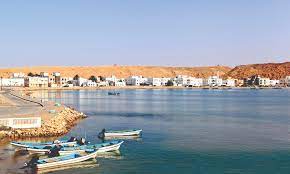
A drive on the coastal road from Muscat to Sur is one of the best ways to experience the resplendent natural beauty of Oman. On route, there are several breathtaking sites to see till you finally reach Sur. Whether it is the ancient archaeological sites or the beautiful beaches and the fishing villages, the journey is indeed memorable.
As you drive from Muscat the first stop on the way is Quriyat. This small fishing town is 83km southeast of Muscat and has many historical landmarks with the first being Quriyat Fort. The fort was built for defense as well as residential purposes. The fort was modified in 1987 to become a museum to contain the states historical pottery and weaponry. Another historical landmark is Sheikh Malik's Mosque which can be seen from a distance.
As you continue to along the road while enjoying the scenic beauty don't miss stopping by at Bimmah Sinkhole. With its emerald-green waters and serene surroundings, the sinkhole — which is located some 120km from Muscat draws visitors from across Oman and all over the world. Tourists who get to see the sinkhole and its pristine waters are more than welcome to descend to the bottom through a concrete staircase that has been erected for just this purpose. Tourists are also welcome to take a dip inside the sinkhole, which in Arabic is also called Hawiyat Najm (the falling star), because it resembles a crater that is formed due to the impact of an asteroid on the earth’s surface. This natural limestone crater has a large concrete staircase that sticks out among the natural landscape, but offers a less precarious way down to the picturesque pool.
As you pass through Bimmah Village you reach the quaint town of Fins. Overlooked by the towering escarpment of Al Hajar Ash Sharqi mountain range is the beautiful bay of the White Beach, near Fins village on the coastal roas. The clear turquoise water of the Sea of Oman here laps sand formed from ancient coral reefs, thus creating one of the area’s most relaxing locations.
Your next stop would be Oman's two most famous wadis - Wadi Shab and Wadi Tiwi. In the midst of awe-inspiring mountains, naturally carved into the most beautiful shapes by the water, there are shallow lakes surrounded by huge boulders, overlooked by narrow rugged trekking pathways attached to the mountains. The lakes provide a great source of relaxation from a rather tedious trek. At the end of the Wadi, there is a small tunnel that leads to a waterfall. Fresh water cascading from tops of the mountains create an environmental diversity unique to this wadi. It will take you around an hour here.
Next head off to Wadi Tiwi. It is another attraction that is fast becoming one of the most sought-after spots for tourists to enquire about. According to Oman’s Ministry of Tourism, Wadi Tiwi features a “spectacularly deep and narrow gorge carved out of the mountains, running between towering cliffs right down to the sea,” and features “old traditional villages, surrounded by lush plantations of date and banana, and criss-crossed with a network of gurgling aflaj”.
If you are a history buff a visit to Qalhat. Qalhat was Oman’s first capital city and this ancient city has witnessed an ancient Omani civilisation and its history dates back to the Bronze Age, when it was a major city and the first capital of Oman. Also, due to many characteristics that augment its unique and distinctive location, and being an important city and port, it had the advantage of attracting travellers, explorers and seekers after knowledge.In the thirteenth century it was the main commercial port linking Oman and abroad.
The city of Qalhat is in the UNESCO list of World Heritage Sites for its historical significance and its role in Oman’s evolution between the 11th and 15th centuries. The ruins of Qalhat include Bibi Mariam’s shrine who is said to be an elderly woman who built a mosque, while some historical sources mentioned that she was the governor of Qalhat during the reign of King Hormuz (Kotob Eddine Yamtuhin). At the shrine entrance, there is a crypt leading to underground corridors beneath the floor of the shrine.
Finally you reach Sur, Oman's port city. Located at the centre of the Governorate of Al Sharqiyah South Sur has a number of famous ancient monuments including Bilad Sur Castle, Sunaysilah Castle, Al Ayjah Castle, Fanar Ras Al Meel and Ras Al Hadd Castle. The Sur Maritime Museum charts the history of shipbuilding in the town. With its strong seafaring connections, it is hardly surprising that the legendary sailor, Sinbad, is thought to have originated there. A replica of the type of boat Sinbad sailed is situated in the Al Bustan roundabout in Muscat. The maritime museum Sur houses pictures and models of Omani ships and their captains and shipbuilders, the ports the ships frequented, as well as the equipment and tools used for navigation, such as instruments, maps, and manuscripts.